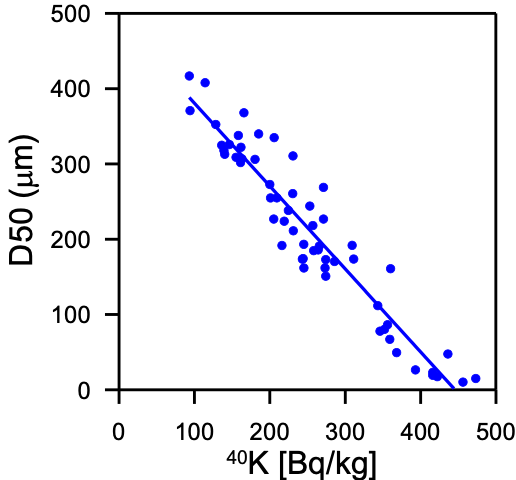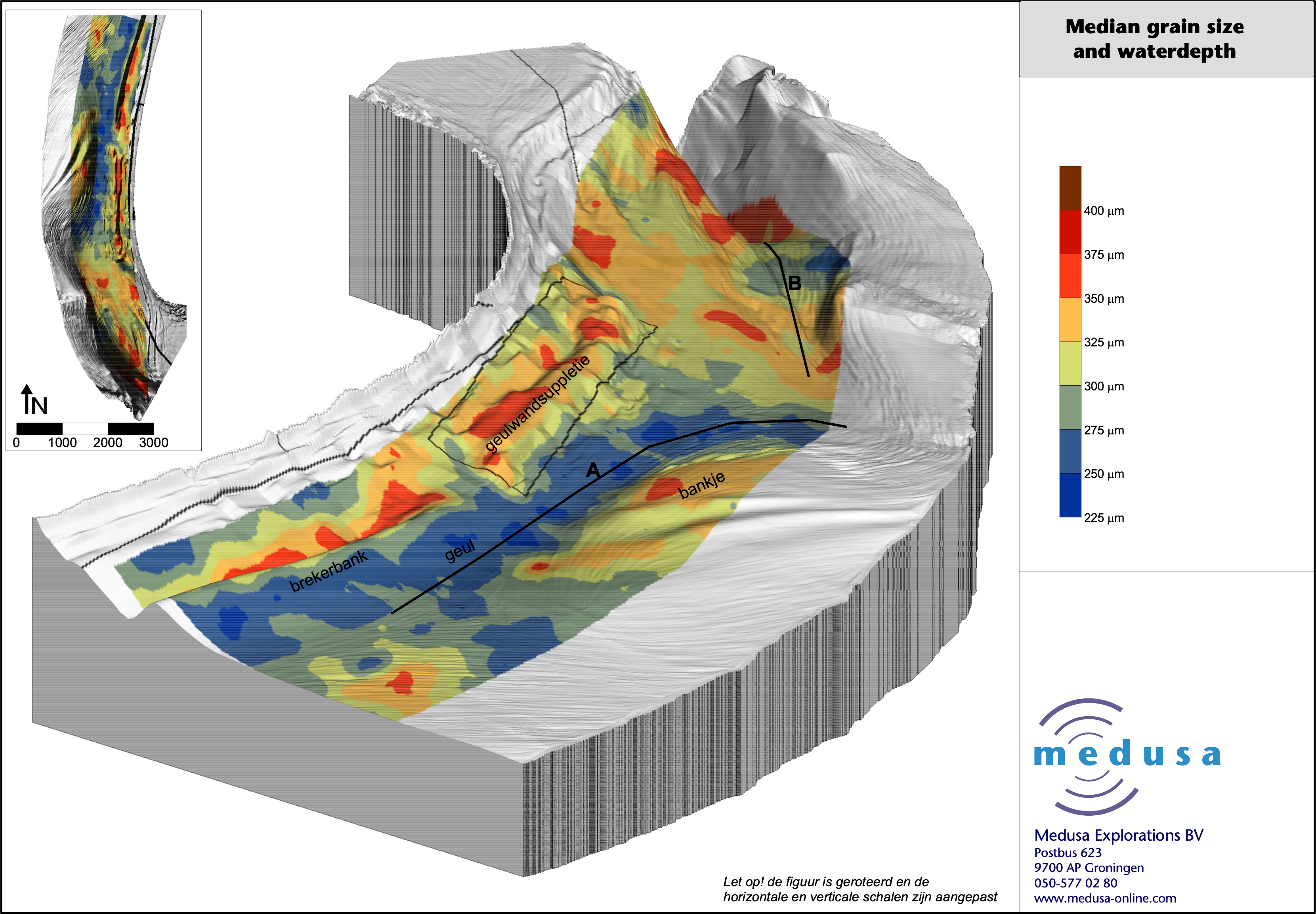Grain size of sediment
Rapid, large scale imaging of the underwater environment is an important issue in geological, environmental and morphological studies of coasts and rivers. An important parameter in these studies is the grain size of the sediment. Present techniques, based on sediment sampling and laboratory analyses, are unable to determine sediment grain size quantitatively and rapid at a high resolution.
Application model
For various projects samples have been measured on grain size and radionuclide concentration. These measurements show a negative correlation between grain size and the concentration of 40K in the sediment: the concentration of 40K increases with decreasing grain size .

Correlation between median grain size (D50) and concentration of potassium in marine sediment samples from the Dutch and Belgian coastline. The sampling sites range from the coastal plain of Belgium to the beach of Texel.
The sample analysis shows that the K-concentration is a measure of the grain size of the sediment. This relation is remarkable but has been observed before and is described by Odom et al. (1976). They studied different Precambrian sandstones by microscopic slides and found that the K-feldspar content increases with decreasing median grain size of the sediment. Their explanation is that feldspars tend to be reduced in size during abrasion, whilst rock fragments and polycrystalline quartz tend to be fragmented and destroyed. This behaviour will cause an increased concentration of fine K-feldspar in sediments that are deposited in highly agitated environments like glacial deposits. If this is true, this relation is location dependent and will not hold for all sedimentary environments (Hsu, 1962; Pollack, 1961). Since feldspars and quartz have an equal density, sorting processes are not expected to be different for quartz and feldspar and feldspar grains of the same size. Hence, the K-content can be used as grain size indicator for K-feldspar as well as quartz.
Mapping of grain size
The relation between median grain size and 40K content was used as an application model in various project that involved mapping rivers and coastal environments. In all projects an MS1200sub was towed behind a vessel in a grid and maps of the radionuclide concentration were made. These maps were translated into maps of grain size of sediments.
The approach was e.g. used to:
- Monitor the sediment transport in a river system
- Map the grain size variation for geological purposes
Map grain size variation in the near shore to understand the behavior of a beach nourishment
This picture shows the grain size variation in a river bend before a high-water discharge ("voor hoogwater") and after a high-water discharge ("na hoogwater"). After the high water discharge, the grain size in the outer bend increases.
.jpg?inst-v=f1a28041-a886-45f8-be27-0360c06a5cb9)
A detailed grain-size map, which was mapped with the MS1200 sub gamma-spectrometer, of the near-shore of the Netherlands. The map is superpositioned on the large-scale grain-size map of that was determined by sediment sampling (Rijkswaterstaat, the Netherlands). The detailed maps shows similar features at a higher resolution and derived at lower costs.

The grain size and water depth of a nearshore section before the coast of Texel, the Netherlands. The mapping of grain size (using a MS1200sub) and water depth (using multibeam) was conducted simultateously. The map shows how the grain size in between the breaker bar and coastline is larger due to sorting processes by wave action. On the seaward side of the breaker bar, grain size is smaller due to sediment sorting processes (Koomans, 2000). At the location of "geulwandsuppletie" a near-shore beach nourishment was conducted prior to the mapping.
References
Hsu, K. J. (1962) Texture and mineralogy of the recent sands of the Gulf Coast. Journal of Sedimentary Petrology, 30(3), pp. 380-403
Koomans, R. L. (2000)Sand in motion: effects of density and grain size. Phd thesis, RUG, Groningen, ISBN 90-367-1338-2.
Odom, I. E. (1976) Nature of feldspar-grain size relations in some quartz-rich sandstones. Journal of Sedimentary Petrology, 46(4), pp. 862-870
Pollack, J. M. (1961) Significance of compositional and textural properties of south Canadian River Channel sands, New Mexico, Texas and Oklahoma. Journal of Sedimentary Petrology, 31(1), pp. 15-37
